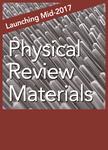版权所有:内蒙古大学图书馆 技术提供:维普资讯• 智图
内蒙古自治区呼和浩特市赛罕区大学西街235号 邮编: 010021

作者机构:Department of Physics Temple University Philadelphia Pennsylvania 19122 USA Condensed Matter Physics and Materials Science Department Brookhaven National Laboratory Upton New York 11973 USA Department of Materials Science and Engineering University of Pennsylvania Philadelphia Pennsylvania 19104 USA Department of Physics and Collaborative Innovation Center for Optoelectronic Semiconductors and Efficient Devices Xiamen University Xiamen Fujian 361005 China Department of Physics Drexel University Philadelphia Pennsylvania 19104 USA Department of Mechanical Engineering and Applied Mechanics University of Pennsylvania Philadelphia Pennsylvania 19104 USA
出 版 物:《Physical Review Materials》 (Physic. Rev. Mat.)
年 卷 期:2017年第1卷第5期
页 面:054002-054002页
核心收录:
基 金:Materials Science and Engineering Divisions Office of Basic Energy Sciences U.S. Department of Energy, USDOE Office of Science, SC Basic Energy Sciences, BES National Natural Science Foundation of China, NSFC, (11335006) National Natural Science Foundation of China, NSFC
主 题:Charge density waves Transition metal dichalcogenides Density functional theory Electron diffraction Electron energy loss spectroscopy Scanning transmission electron microscopy Transmission electron microscopy
摘 要:We present a three-dimensional study on the anisotropy of the charge density wave (CDW) in 1T−TiSe2, by means of in situ atomically resolved electron microscopy at cryogenic temperatures in both reciprocal and real spaces. Using coherent nanoelectron diffraction, we observed short-range coherence of the in-plane CDW component while the long-range coherence of out-of-plane CDW component remains intact. An in-plane CDW coherence length of ∼10nm and an out-of-plane CDW coherence length of 17.5 nm, as a lower bound, were determined. The electron modulation was observed using electron energy-loss spectroscopy and verified by an orbital-projected density of states. Our integrated approach reveals anisotropic CDW domains at the nanoscale, and illustrates electron modulation-induced symmetry breaking of a two-dimensional material in three dimensions, offering an opportunity to study the effect of reduced dimensionality in strongly correlated systems.